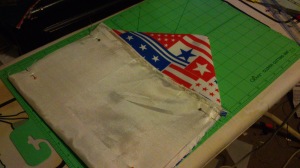Heyyy Youu Guyyyyys!
I have encountered another first fellow crafters- the sewing machine service!
Now obviously my machine decided to shout at me slap bang in the middle of a big project for my good friend Emma at My Vintage, so I was a tad frightened! I couldn’t afford to send my machine away to be fixed, let alone buy a new one if it was truly dead. So, I took to Google and low and behold I found the answer, and like a good blogger and Pinterest ADDICT I pinned it and read it. This is an eBay post from a sewing machine specialist/wizard who decided to write a helpful guide as to what to do if your machine stops working, as more often than not it just needs a good clean! So I duly headed to my Dad’s cellar and hunted around. From my time in the Army Cadets I knew a brush would be needed and some oil! Anything with moving parts needs dusting and anywhere where metal brushes against metal needs oiling. Simple Fact. I also grabbed some long nose pliers (tweezers would work just as well) just in case I needed to pick dirt out, and I grabbed a flat head screwdriver, some WD40 (life-saving oil 101!) and a torch! I then went to my tutorial and got quite scared. Like I said before I couldn’t afford to replace my machine, so I didn’t want to begger it up using the wrong tools! And it stressed to refer to your manual (which I didn’t have), and NOT to use ANY other oil other than Sewing Machine Oil. Now, I’m very lucky as I work in a haberdashers so I was able to pick up a maintenance kit and sewing machine oil pretty sharpish for £3.19 and £1.79 respectively. HOWEVER! I happen to know that Sewing machine oil is in most Pound Shops around here (or Dollar Stores for our cousins over the pond) and in my maintenance kit I got two screwdrivers and a nylon brush. Now, the nylon brush is handy as it is the BEST for picking up dust and dirt but you could use a simple paintbrush if you wanted. As far as the screwdrivers go, it turned out that I had a tool in my sewing machine’s secret compartment! After returning to my tutorial it turned out I would have been OK with what I already had in my house, except the machine oil which needed to be bought… *facepalm*. (Oh, and I managed to download my machine’s manual for FREE!)
I consoled myself slowly, “Of course the maintenance kit is going to be good as it’s what it’s designed for” la de da, so if you do have the extra pennies it’s a good investment, and for £3.19 it wasn’t too bad 😉 however it isn’t 100% necessary.
The tutorial really covers most things, as will your manual if you have it/can download it. Rule of thumb is: Dust down first, especially around the dog feeders (the little teeth that move your fabric). If metal is rubbing against metal, oil it! Not too much, you’ll only need a drop (or two at most!). I was certain my machine was truly broken, but it turned out the it just needed a spring clean, and a new needle.
I feel silly for panicking,I should have put my thinking cap on and thought logically and thriftily, but for £5 worth of stuff I saved a £150 service bill. Looking at those figures… I ain’t even mad!

Stay tuned for a lovely Minerva Post hitting the KB Blog this Friday! This will DEFINITELY make up for any thrift-faux pas I made this week!
Craft or Glory!
Katie B xo







